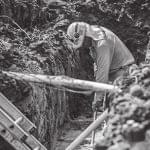Hiring new employees means teaching them the ins and outs of the job, including being open and honest about your company’s safety program and expectations. You may have a top safety culture, with veteran employees who all understand the importance of safety to a happy, healthy, successful workplace and jobsite. But what about those new workers fresh out of school and ready to work? How are you teaching your new employees everything they need to know about working safely?
An Industry Full of New Workers
According to the Associated General Contractors of America (AGC), construction employment in June 2019 was up in 42 states and the District of Columbia from June 2018. Construction continues to grow overall, according to a March 2019 AGC press release, even though the industry is seeing uneven growth due to tight government budgets, plunging commodity prices, and weak overseas demand. In states seeing the most growth, like California, Florida, Washington, and Texas, there is also a growing shortage of qualified construction workers. “We’re all facing a shortage of construction workers,” said Carl Heinlein of the American Contractors Insurance Group. “We have wonderful folks coming into the industry, but they might not have any experience with construction in the field.” Even those new professionals who have gone through construction management degree programs likely have little to no actual field experience, leaving their new managers and supervisors to show them the ropes of just about everything. And in an industry in which 991 workers were killed on the job in 2017, accounting for 21 percent of all fatal work injuries across all industries, knowing what to do and how to do it safely is the most important skill of all.
Lack of Skill Creates Problems
According to Heinlein, many of those injuries come when a job is not done correctly the first time and must be reworked. A lack of time, the proper equipment, and the doubled exposure to risk are often what lead to reportable incidents. “When you have a workforce that is aging, with new folks coming in and new subcontractors coming in, there is a turnover of information,” Heinlein said. “It’s a lack of experience, and there is a lot of pressure on our supervisors, more than ever before.”
The Right Trainers are Key
But with that pressure comes the responsibility of training that next generation of workers. Heinlein suggested one of the best ways to train is to have more experienced, even retired, workers come back to the field to help mentor their replacements. The biggest challenge is making sure that those trainers are actually teaching the new workers how to perform instead of getting frustrated with the speed or ability and taking over the job themselves. Having retired workers who will no longer be around helps ease this issue. “The retirement of a lot of experienced folks leaves a void – or an opportunity, depending on how you deal with it,” Heinlein said. “You hate to lose that experience, but some companies are truly mentoring to help the younger, newer folks grow successfully.” Heinlein said he often sees companies hesitant to fully train new employees right away for fear that they will just leave for another organization, making all the time and money spent on training a waste. But the overarching impact of safety on the construction industry as a whole, he said, is more important than the fear of losing one worker to the competition. Finding the right people to do the training and to exhibit the company’s culture is key, however. A new employee will automatically follow the lead of the person he or she is placed under, and that first impression can make a huge difference. “If I go to orientation class and hear one thing, but then I go out to a project and don’t see it, the climate is disconnected,” Heinlein said. “As a new worker, I don’t raise a lot of cane because I want to work and make money. But in most cases workers are going to follow what the leaders on the project say and do.” No one wants to get hurt on the job, but there can be a tendency in veteran workers to take shortcuts to get work done “just this one time.” That sets a dangerous precedent for anyone just starting out. Heinlein said for that reason he coaches his contractors to put new employees with the best, most consistent crews and supervisors. “In working with supervisors and foremen on a regular basis, I tell them, ‘Everyone is watching you,’” he said. “‘If you care and it’s important to you and it’s what you do, it will become important to them. But if you say one thing and do another, they’ll think it’s not important.’” 
Knowing What to Expect
Being direct in intentions and expectations also keeps everyone safe, Heinlein said. “Most people would rather work with those are crystal clear on what they do and what they expect,” he said. “Second-guessing and being wishy-washy creates safety, productivity, and quality issues.” Even those new employees who have gone through college or university construction management programs have a lot to learn from on-the-job training. They need someone they can trust and look up to while they’re learning how to do their jobs. In fact, Heinlein said, the majority of them have been taught to do estimating, management, etc., but they rarely get any safety training while in school. “At best, safety is 5 percent of their curriculum,” he said. “You’ve got that one shot when an individual walks through the door. Is it just going to be talk, or is it truly ingrained in what we do every day?”
